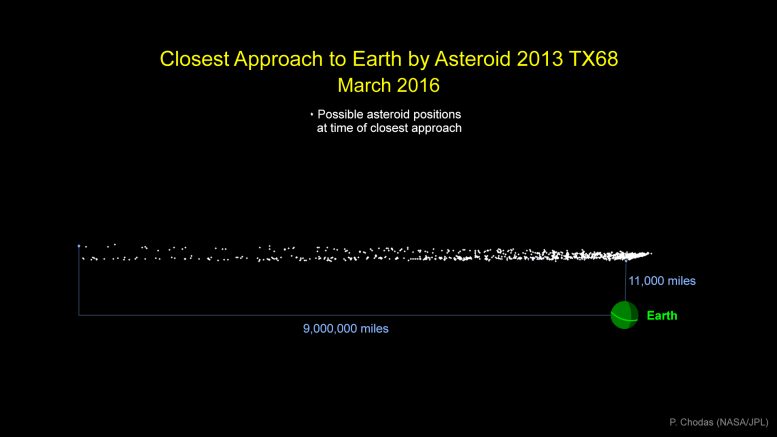
Asteroid 2013 TX68 (which flew past Earth at a comfortable distance of about 1.3 million miles two years ago) will safely fly by our planet again in a few weeks, though this time it may be much closer.
During the upcoming March 5 flyby, asteroid 2013 TX68 could fly past Earth as far out as 9 million miles (14 million kilometers) or as close as 11,000 miles (17,000 kilometers). The variation in possible closest approach distances is due to the wide range of possible trajectories for this object since it was tracked for only a short time after discovery.
Scientists at NASA’s Center for NEO Studies (CNEOS) at the Jet Propulsion Laboratory in Pasadena, California, have determined there is no possibility that this object could impact Earth during the flyby next month. But they have identified an extremely remote chance that this small asteroid could impact on September 28, 2017, with odds of no more than 1 in 250 million. Flybys in 2046 and 2097 have an even lower probability of impact.
“The possibilities of collision on any of the three future flyby dates are far too small to be of any real concern,” said Paul Chodas, manager of CNEOS. “I fully expect any future observations to reduce the probability even more.”
Asteroid 2013 TX68 is estimated to be about 100 feet (30 meters) in diameter. By comparison, the asteroid that broke up in the atmosphere over Chelyabinsk, Russia, three years ago was approximately 65 feet (20 meters) wide. If an asteroid the size of 2013 TX68 were to enter Earth’s atmosphere, it would likely produce an air burst with about twice the energy of the Chelyabinsk event.
The asteroid was discovered by the NASA-funded Catalina Sky Survey on October 6, 2013, as it approached Earth on the nighttime side. After three days of tracking, the asteroid passed into the daytime sky and could no longer be observed. Because it was not tracked for very long, scientists cannot predict its precise orbit around the sun, but they do know that it cannot impact Earth during its flyby next month.
“This asteroid’s orbit is quite uncertain, and it will be hard to predict where to look for it,” said Chodas. “There is a chance that the asteroid will be picked up by our asteroid search telescopes when it safely flies past us next month, providing us with data to more precisely define its orbit around the sun.”
For regular updates on passing asteroids, NASA has a list of the next five close approaches to Earth; it links to the CNEOS website with a complete list of recent and upcoming close approaches, as well as all other data on the orbits of known NEOs, so scientists and members of the media and public can track information on known objects.
Never miss a breakthrough: Join the SciTechDaily newsletter.